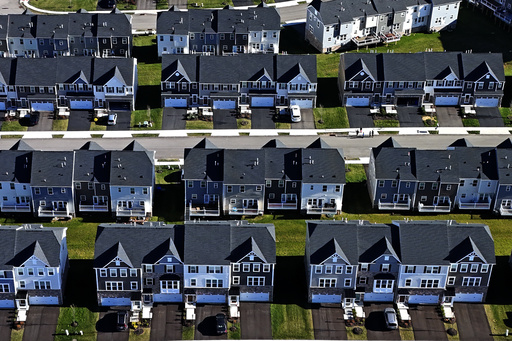
If Donald Trump secures the presidency once again, many Republicans are optimistic he will advance a long-held objective of the party: privatizing the mortgage entities Fannie Mae and Freddie Mac, which have remained under federal oversight since the 2008 financial crisis.
However, this move faces opposition from Democrats and several economists who caution that privatizing these firms amid the current high mortgage rates could lead to increased costs for homebuyers.
Republicans argue that the Federal Housing Finance Agency has maintained control over Fannie Mae and Freddie Mac for far too long, inhibiting competition in the housing funding sector and placing taxpayers at risk for potential future bailouts akin to the one seen in 2008. Trump previously attempted to liberate these agencies from governmental oversight during his administration, but the victory of Joe Biden in 2020 halted those efforts.
Concerns among Democrats center on the possibility that privatization would drive up mortgage costs, as Fannie Mae and Freddie Mac would likely need to raise their fees to account for the greater risks they would face without federal backing. These two entities underwrite about half of the $12 trillion U.S. mortgage market and play a critical role in the nation’s economic stability.
The Project 2025 document, a framework for a future Republican administration, prominently features a push to end the conservatorship of these mortgage giants. Although Trump has tried to distance himself from this comprehensive 920-page report created by allies and former administration officials, it remains a significant aspect of the GOP agenda.
During a rally in North Carolina, Kamala Harris, the Democratic presidential nominee, emphasized the potential financial burden of Trump’s plans, estimating that implementing the Project 2025 agenda could increase yearly mortgage costs for average Americans by approximately $1,200. This statement builds on a previous assessment from 2015 by economists Jim Parrott and Mark Zandi, who found that a privatized Fannie Mae and Freddie Mac would need more capital to manage risk-laden loans, leading to higher mortgage rates or reduced lending options.
Parrott, associated with the Urban Institute, and Zandi, chief economist at Moody’s Analytics, concluded that if these companies were privatized, rates for 30-year fixed mortgages could rise between 0.43% and 0.97%. Given the average home loan of about $244,500 as of 2023, homebuyers could face annual costs escalating by approximately $730 to $1,670.
Surprised by the revival of his analysis nearly ten years later, Parrott reaffirmed his stance. “Privatization would cause a substantial increase in housing costs for the majority of Americans,” he asserted. Parrott previously contributed to the National Economic Council under Barack Obama.
On the contrary, economist Mark Calabria, who led the FHFA during Trump’s tenure, believes these worries are exaggerated. He contends that the federal government is obliged to transition Fannie Mae and Freddie Mac back to private ownership.
Calabria dismissed the concerns raised by Zandi and Parrott, asserting that the financial health of Fannie Mae and Freddie Mac has improved significantly, making it feasible to achieve privatization by 2027, provided they acquire the necessary funds to operate independently.
Calabria stated, “I don’t think there should be any apprehensions about sudden changes in mortgage prices.” He believes that reforming Fannie Mae and Freddie Mac is essential to ensure responsible lending practices and prevent future bailouts in the mortgage sector.
While Trump has not explicitly indicated whether he intends to revisit the idea of ending conservatorship, he previously expressed his disappointment to Senator Rand Paul in 2021 regarding the failure of his privatization initiative. He mentioned to Paul, “My Administration was denied the time it needed to address this issue.” The Trump campaign chose not to provide comments on his current stance about the conservatorship.
A crucial point raised by Parrott is whether a privatized version of Fannie Mae and Freddie Mac would still carry some form of government guarantee, whether explicit or implicit, safeguarding them from failures.
How Trump’s administration would navigate this issue would largely determine whether the process of privatization would be only slightly disruptive or significantly alter the housing finance landscape, Parrott noted. Before being placed under government control in 2008, these entities operated as private companies while still benefiting from an implicit government assurance, resulting in a bailout after the housing market crash and subsequent defaults.
The firms have since repaid their $187 billion in bailout funds and have contributed billions back to the government in dividends. However, the previous bailouts have left many Republicans wary of reinstating any government backing, as they believe taxpayer funds should not be allocated to rescuing mismanaged institutions.
Yet, without such guarantees, Parrott warned of a substantial risk of instability in the market, which could hinder access to mortgages for many, essentially leaving only borrowers with top-tier credit profiles eligible for loans. Parrott characterized this scenario as a potential “worst-case outcome.”
Calabria refuted those concerns, asserting that there is no need for a federal guarantee, pointing out that other significant firms bailed out during the 2008 crisis, such as Citibank, AIG, and General Motors, have remained public entities without requiring conservatorship.
He questioned, “Why are we treating Fannie and Freddie differently?” pointing out that the same laws applicable to Citibank apply to them.
With interest rates anticipated to decline over the next year, Parrott expressed skepticism about the likelihood of privatization under a new Trump administration, suggesting that officials would recognize the adverse market implications of such a move.
It might be challenging for a president to justify to homeowners that measures would be implemented to raise mortgage rates to levels that had previously led to widespread financial distress, according to Parrott.
